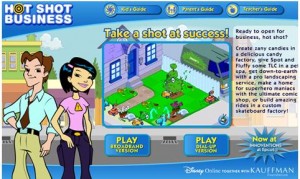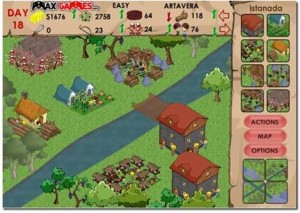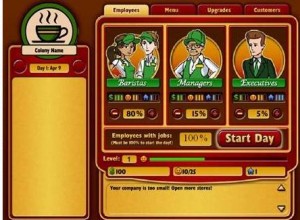Overview
Simulations have been used in classrooms for decades (Harper, Squires & McDougall, 2000). One group member reminisced using the board game Monopoly in accounting class to simulate how to run a business. With the advent of computers, simulations have become much more sophisticated.
Simulations are “computationally correct representations of a situation which offer the user control over the outcome of the program” (Davies, 2002, p. 272). A study by Davies revealed criteria of a successful simulation. Specifically, the simulation must involve a task or situation that is both “authentic and meaningful” (Davies, 2002, p. 280). Secondly, students must be provided with an opportunity to work collaboratively and share understandings from the simulation. Students must also be given time to “master the simulation” so the learning that takes place is about the learning objective and not the navigation of the simulation (Davies, 2002, p. 280). In addition, it is critical that the objective of the simulation be consistent with the learner’s objective (Davies, 2002).
Advantages
One of the biggest advantages of using simulation is that they connect abstract learning that takes place in the classroom with real-world problems (Liu & Tu, 2012). The authenticity of tasks also leads to greater student engagement as students feel a greater “sense of ownership of the task” (Davies, 2002, p. 272). I note an increase in self-regulation when using a business simulation with my senior students. The simulation requires two student inputs per week. After the first week, students don’t require any prompts to complete their inputs and many times, the inputs are completed well in advance of when they are due.
Simulations allow students to actively participate in the learning process and provide students with opportunities to practice skills, pilot different strategies and make adjustments to their strategies based on the results of their original decision making (Gibson & Kruse, 2011).
Items for Consideration
Using simulations requires a significant time investment. The educator must become familiar with the simulation before the students start using it. There is also the potential for technical difficulties when working with the simulation. For example, it may be necessary to obtain approval to permit the simulation to run on the school network and the school technician may not be in a position to assist with troubleshooting should something go wrong.
Simulations could also result in the “potential loss of control by the academic instructor over student learning” (Moizer, Lean, Towler & Abbey, 2009, p. 209). Some teachers may be uncomfortable in this new environment due to the uncertainty introduced.
There is also a risk that students will not buy-in to participating in the simulation. Potential causes of student resistance could include student immaturity and/or a simulation that is too complicated or difficult to navigate.
In the group’s experience, the advantages of using simulations have outweighed the potential pitfalls. The learning that occurs is meaningful as it relates to authentic, real-world situations. So where do you stand on the use of simulations?
Examples of Simulations
Allows the user to create one of five business to run including:
- Pet Spa
- Skateboard Factory
- Custom Skate
- Pro Landscaping
- Comic Shop
In this simulation, you get to build an empire from the ground up. You are also responsible for developing trade in your empire and amassing an army to defend your empire from nearby kingdoms.
Ever dreamed of owning a coffee shop? Then this simulation is for you! In this game, you are the owner of a coffee shop and make decisions about the menu, advertising, coffee plants and equipment purchases.
A simulation that lets you buy and sell real estate with the addition of energy management. You can decrease the amount of energy used by your neighbourhoods by using wind farms and solar energy.
References
Chandra, P. (2009). Coffee Tycoon [Image]. Retrieved May 25, 2012 from http://www.makeuseof.com/tag/top-10-free-online-tycoon-games-you-should-play
Chandra, P. (2009). Imperium [Image]. Retrieved May 25, 2012 from http://www.makeuseof.com/tag/top-10-free-online-tycoon-games-you-should-play
Chandra, P. (2009). Top 10 online tycoon games you should try. Retrieved from http://www.makeuseof.com/tag/top-10-free-online-tycoon-games-you-should-play/
Davies, C.H.J. (2002). Student engagement with simulations: A case study. Computers & Education, 39(3), 271-282. doi: 10.1016/S0360-1315(02)00046-5
Disney Insider. (2012). Hot Shot Business. Retrieved from http://disney.go.com/hotshot/today.html
Hot Shot Business [Image]. (2012). Retrieved May 25, 2012 from: http://disney.go.com/hotshot/today.html
Gibson, D. & Kruse, S. (2011). Next generation learning challenge: Simulated teaching. Educause Quarterly, 34(4). Retrieved from http://www.educause.edu/EDUCAUSE+Quarterly/EDUCAUSEQuarterlyMagazineVolum/NextGenerationLearningChalleng/242797
Harper, H., Squires, D., & McDougall, A. (2000) Constructivist simulations: A new design paradigm. Journal of Educational Multimedia and Hypermedia, 9(2), 115-130.
Lin, Y. & Tu. Y. (2012). The values of college students in business simulation game: A means-end chain approach. Computers & Education, 58(4), 1160-1170. doi:10.1016/j.compedu.2011.12.005
Moizer, J., Lean, J., Towler, M. & Abbey, C. (2009). Simulations and games: Overcoming the barriers to their use in higher education. Active Learning in Higher Education, 10, 207-224. doi:10.1177/1469787409343188
Yummy Games. (2010, September 28). Build-a-Lot 4: Power Source Game Trailer [Video file]. Retrieved from https://www.youtube.com/watch?v=PP1dmQMtGLs&feature=results_video&playnext=1&list=PL5C35179AF3E4054A
Authored by Deborah Schell



